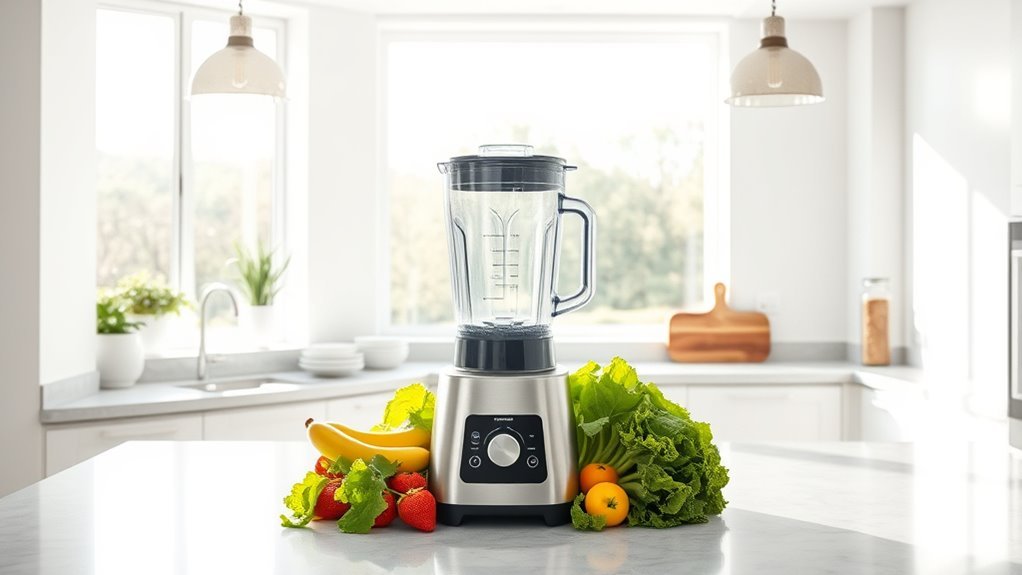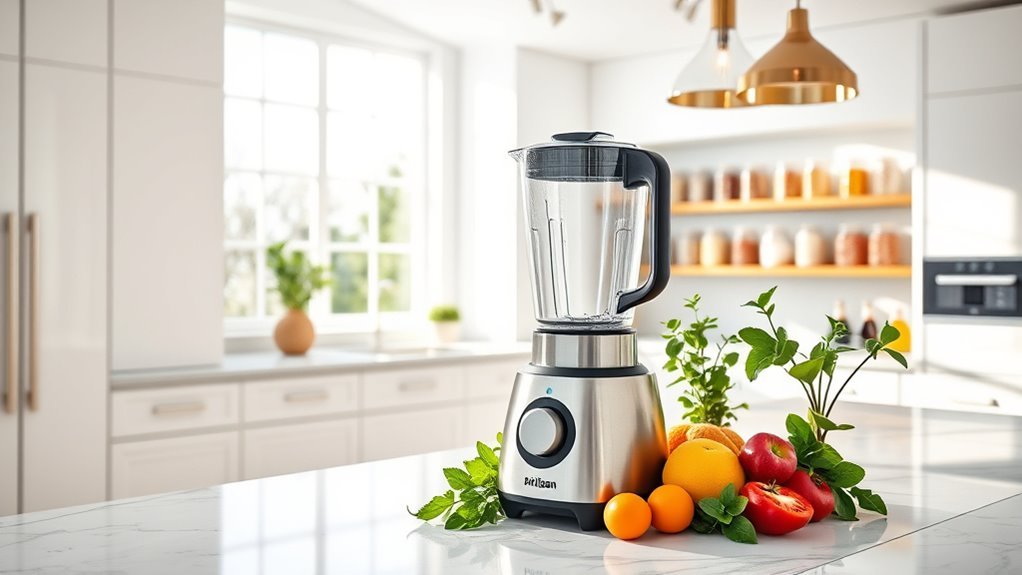High-quality blender containers outperform in dishwashers thanks to precise engineering and material selection. We’re looking at containers with detachable blades, reinforced bases, and smart designs that prevent food trapping. The best ones use BPA-free plastics or specialized glass that handle temperatures up to 180°F while resisting detergent damage. Their wide-based, tapered shapes guarantee thorough cleaning with minimal residue buildup. Understanding these features reveals the secret to spotless results.
Understanding Material Selection and Durability

When it comes to blender containers, material selection makes or breaks your dishwasher experience.
We’ve found that high-quality plastic containers often outperform their glass counterparts in dishwasher durability, thanks to their resistance to warping and structural flexibility.
Let’s get real about what makes a container dishwasher safe. The thickness and quality of materials directly impact how well your container survives repeated washing cycles.
Premium BPA-free plastics, when properly engineered, won’t crack or degrade like cheaper alternatives. While glass containers resist staining and odors beautifully, they’re heavier and demand specific care in the dishwasher.
Smart manufacturers design with dishwasher compatibility in mind – it’s not just about the material itself, but how it’s molded and reinforced to handle thermal stress. High-performance blenders often utilize durable materials that enhance the longevity of their containers, making them ideal for frequent use in dishwashers.
Design Features That Enhance Dishwasher Safety
Three key design elements make a blender container genuinely dishwasher-safe, and we’re not talking about basic features here. Let’s examine how smart design enhances dishwasher safety through detachable parts, reinforced structures, and cleaning-optimized surfaces.
| Feature | Purpose | Benefit |
|---|---|---|
| Detachable Blades | Easy Cleaning | Thorough Sanitization |
| Reinforced Base | Temperature Resistance | Prevents Warping |
| Smooth Surfaces | Reduces Food Buildup | No Odor Retention |
| Thick Walls | Chemical Resistance | Extended Lifespan |
| Ergonomic Design | Fewer Crevices | Easy to Clean |
We’ve found that containers with these features aren’t just easier to clean – they’re built to last. The detachable parts mean you’ll get a deeper clean, while those reinforced bases laugh in the face of high-temp cycles. Additionally, investing in containers with these design elements can complement the high-performance blenders that require advanced maintenance. Trust us, it’s worth investing in containers with these dishwasher-friendly design elements.
Heat Resistance and Temperature Tolerances

Understanding your blender’s heat tolerance isn’t just about preventing warped containers – it’s about protecting your investment.
We’ve got to match your container’s temperature tolerances with proper dishwasher settings for maximum longevity.
Here’s what you need to know about heat resistance and dishwasher-safe containers:
- High-quality plastic containers handle temps up to 180°F (82°C) – stick to standard cycles.
- Glass containers resist heat better but need careful placement to avoid thermal shock.
- Skip the heat-dry option – it’s overkill and can damage both materials over time.
- BPA-free plastic engineering means better structural integrity, but don’t push your luck with extreme temperatures.
Remember: manufacturer temperature ratings aren’t suggestions – they’re limits.
Smart temperature management keeps your blender container serving smoothies, not warping into abstract art.
Impact of Detergents on Container Materials
Since detergents pack a chemical punch, they’re quietly waging war on your blender container’s materials.
We’ve seen how dishwasher detergents can wreak havoc on plastic containers, causing warping and discoloration that’ll make you wish you’d hand-washed instead.
Here’s the dirty truth: Those aggressive cleaners don’t play nice with everything.
They’ll fade your container’s measurement marks faster than you can say “potential damage.”
Even high-quality, dishwasher-safe containers aren’t immune to detergent buildup over time.
While manufacturers promise easy cleaning, harsh chemicals can leave behind stubborn residues that defeat the purpose.
The pH levels in these detergents matter more than you’d think.
That’s why we’re seeing more containers specifically engineered to resist chemical assault, ensuring your blender stays readable, functional, and film-free.
Container Shape and Cleaning Efficiency

When it comes to dishwasher success, your blender container’s shape makes all the difference.
We’ve found that container shape directly impacts cleaning efficiency, and it’s essential to understand why some designs work better than others.
- Wide-based, tapered containers create ideal water flow, guaranteeing thorough cleaning from top to bottom.
- Smooth sides without textured surfaces prevent food from getting trapped, making your cleaning routine more effective.
- Containers with minimal grooves and crevices reduce residue buildup and require less careful handling.
- Shorter, wider designs fit better in most dishwashers compared to tall, narrow ones that risk poor cleaning and damage.
Let’s be clear: if you’re shopping for a new blender, prioritize these shape features.
They’ll save you time and guarantee your container emerges spotless after every wash cycle.
Long-Term Performance in Commercial Dishwashers
Although commercial dishwashers put blender containers through intense punishment, today’s high-quality materials can take the heat. We’re seeing remarkable long-term performance from containers made with premium stainless steel and robust plastics – they’re practically built for battle.
Let’s be clear: these aren’t your standard kitchen containers. The best commercial models feature reinforced construction that laughs at high temperatures while keeping their professional appearance cycle after cycle.
They’re engineered with detachable parts for quick cleaning – essential when you’re running a busy kitchen.
Don’t cheap out on materials, though. Lesser-quality containers will show their weakness fast. Dull blades, cloudy surfaces, warped walls – we’ve seen it all.
In commercial dishwashers, only the strong survive.
Frequently Asked Questions
Are Blender Containers Dishwasher Safe?
We’ve found most blender containers are dishwasher safe, but container durability varies by materials used. Check manufacturer’s guidelines, as cleaning efficiency and dishwasher materials can impact your container’s long-term performance.
Is It Okay to Put a Ninja Blender in the Dishwasher?
Like devoted kitchen ninjas, we can put most Ninja blender containers in the dishwasher’s top rack, but let’s hand wash those blades to maintain their sharpness and guarantee safety.
Can I Put a Vitamix Container in the Dishwasher?
We can put most Vitamix containers in the dishwasher, except Classic 64oz and 32oz models. For best durability, use the top rack and avoid heat-dry settings, or try the self-cleaning method instead.
Can a Blender Be Washed in the Dishwasher?
Like steering through tricky waters, we’ll tell you that most blender containers can go in the dishwasher, but we recommend checking the container materials and using low dishwasher temperature for safe cleaning methods.

